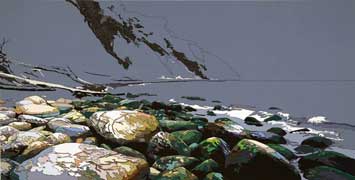
Ruegens Rocks, 2005.
Stitched fabric,
69" x 136"
Rowena Dringby Donald Goddard |
 Ruegens Rocks, 2005. Stitched fabric, 69" x 136" |
The elements, all belonging to landscapes without human or other animal intrusions, are rather few in Dring's work--sky, water, earth, sand, leaves, tree trunks, branches, hills, horizon, rocks. So are the colors; there seem to be about 60 or 70 different ones in the most profuse pictures, from the 300 or so color fabrics the artist has collected in her travels. The statistical possibilities in combining these numbers of elements and colors, however, are finitely enormous, as in nature they would be simply infinite. And then, of course, the abstract shapes of colored fabric that make up the picture are also many in number, though finite. |
 Emerald Forest, 2005. Stitched fabric, 88 5/8" x 70 7/8" |
From the moment you see these landscape pictures you are aware they are simultaneously places that exist and abstract color constructions. It's not that the places themselves are important, famous, romantic, or archetypal but that they encompass an extraordinary range of the possibilities of life on earth. And it's not that all works of visual art are not abstract color constructions, but that these are literally pieced together as though from some brilliant master plan. Of course, the master plan was in what was originally seen and photographed by Dring, and then it became her master plan as the original photo was transformed into a computerized matrix and a sewing pattern. If Roy Lichtenstein and Chuck Close exploited the four-color process of mechanical reproduction to create, or celebrate, illusion, Dring uses digital technology to reaffirm and make even more real what she has experienced. A strange and powerful collusion emerges between what has naturally formed and grown in the world and what has been shaped and puzzled together by the artist. The artist is everywhere, especially in the black machine stitching that runs throughout, pulling things together, like drawing, and even runs on its own to create, for instance, the contours and shadows of the distant hills in Ruegens Rocks. |
 Willow and Water--the Remix, 2004. Stitched fabric, 88 3/4" x 70 1/2" |
Nature only rarely offers broad expanses of uninflected color, stases of light, though it sometimes appears that way in skies, deserts, and oceans. There are such expanses in Dring's work: the white water of Willow and Water; the black trunks and branches of Emerald Forest; the blue sky, hills, and water of Ruegens Rock. They are like the blankness of the canvas, that which makes everything on it possible as an image and part of a composition. But they are not that. They are something in themselves, like the great black slashes of the trees in Emerald Forest, which spread in two sweeping pieces through the height and breadth of the picture, and they fit in with all the other smaller expanses of color down to the tiniest dot of color. One thinks of foreground and background as they are usually perceived, but in fact it is impossible to separate the shapes of color in this way, except perceptually, particularly since they are so tightly sewn together. So the level of what we might think of as reality can never be ascertained. What does happen is that the color shapes, which in their multifarious juxtapositions represent growth, reflection, and various environmental conditions, repeat in their making and binding together, the very processes that they represent. The artist is literally making trees and sand and water and sky with the materials she uses. Donald Goddard © 2005 |
|
The exhibition at Elizabeth Dee Gallery, 545
West 20th Street, New York, NY 10011.
|
Art Review - NYArtWorld.com - NYAW.com. All artwork is copyright of the respective owner or artist. All other material © Copyright 2015 New York Art World ®. All Rights Reserved.
New York Art World ® - Back to Top